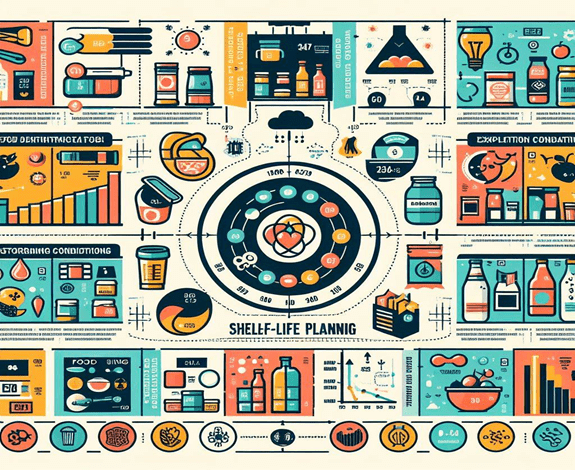Shelf life, the critical timeframe within which a product remains safe and effective, is an essential component of inventory and supply chain management. For companies dealing with perishable items like food, pharmaceuticals, and cosmetics, understanding and managing shelf life is not just a matter of efficiency. It’s a lot more. This understanding ensures that products are sold and consumed at their peak quality, safeguarding consumer satisfaction and safety.

SAP Integrated Business Planning (IBP) is a powerful tool that helps businesses optimize their supply chain operations. One essential feature of SAP IBP is shelf life planning, which we will discuss in detail in this blog post and explore the benefits it drives for businesses.
Businesses must integrate shelf life planning with other modules and functionalities within the platform to fully leverage the benefits of shelf life planning in SAP IBP. This includes demand planning, inventory optimization, and order fulfillment. By integrating these modules, businesses can create a seamless end-to-end supply chain process that maximizes shelf life visibility, minimizes wastage, and improves overall business performance.
As such, the planning process involves several essential elements integral to effectively handling products with limited shelf life.
Expiry Management: Tracking and managing product expiration dates to proactively address potential stock-outs, reduce waste, and ensure compliance with regulations
Businesses can accurately define their products’ expiration dates, harnessing Shelf life planning in SAP IBP. By configuring appropriate shelf life parameters, companies can guarantee that products are sold before their expiration dates, which helps to minimize waste and avoid expensive penalties for selling expired goods. This level of accuracy in expiration date management is particularly essential for industries with strict regulations, such as the pharmaceutical industry.
Product Segmentation: An elegant and well-defined process of categorizing products based on their shelf life characteristics, such as perishable, semi-perishable, or non-perishable, to facilitate tailored planning and forecasting.
This approach ensures that inventory management can be accurately tailored to the needs of different product categories. For example, perishable goods like dairy products require swift turnover and optimal storage conditions to minimize waste and ensure freshness. On the other hand, non-perishable items such as canned goods have a significantly longer shelf life, allowing for longer-term planning and less frequent restocking. By understanding and applying these distinctions, businesses can optimize their supply chain operations and improve overall efficiency.
Quality Control: Integrating quality parameters and standards into the planning process to maintain product freshness and integrity throughout its shelf life.
This allows for a systematic assessment of every product aspect, from raw materials to final packaging, to ensure that each product remains fresh and maintains its integrity until the end of its shelf life. For example, in the food industry, this might involve setting strict temperature controls during transportation and storage or specifying handling procedures to minimize the risk of contamination. By adhering to these predefined quality parameters, companies can significantly reduce waste and returns, increasing customer satisfaction and loyalty. This proactive stance on quality control underscores a commitment to excellence and safety, setting a high standard within the industry.
Forecasting and Demand Planning: Supply chain executives can accurately forecast product demand within their respective shelf lives, aiding inventory optimization by utilizing historical data, market trends, and predictive analytics.
This process gathers and analyzes vast amounts of data from past sales, current market conditions, and potential future events that could influence demand. Advanced algorithms and models are then applied to this data to identify patterns and predict future demand accurately. By understanding these patterns, businesses can adjust their inventory levels accordingly, ensuring they have the right stock. This minimizes waste due to spoilage and ensures meeting customer demand efficiently, leading to increased customer satisfaction and reduced costs.
Inventory Optimization. Involves balancing stock levels to align with demand patterns and shelf life constraints, ensuring minimal product wastage and maximum customer satisfaction.
Driven by forecasting and demand planning, IBP allows companies to precisely align inventory with consumer demand and product expiration dates. Companies can reduce excess stock and avoid the costs associated with unsold goods. This frees warehouse space and optimizes cash flow, allowing for more strategic investment in high-demand products.
Other Factors to Consider
Shelf life planning in SAP IBP enables businesses to manage their inventory more efficiently by considering temperature changes, humidity, and storage conditions. This allows for accurately estimating a product’s remaining shelf life throughout the supply chain. It facilitates informed decision-making regarding stock rotation, order fulfillment, and production planning, enhancing customer satisfaction by delivering fresher, higher-quality products. Moreover, it aids in swiftly managing product recalls by quickly identifying affected items, minimizing health risks, and protecting brand reputation.
Collaborating with suppliers, distributors, and retailers further streamlines the flow of perishable goods, reduces lead times, and optimizes transportation, preserving product shelf life and contributing to a competitive advantage.
As a leading SAP Partner globally, YASH has effectively enabled businesses to use shelf-life planning within SAP IBP. Leveraging YASH’s expertise and comprehensive suite of solutions, organizations can seamlessly integrate modules, such as demand management, inventory optimization, and supply planning, to effectively manage perishable inventory. YASH’s tailored approach aligns product segmentation, demand forecasting, expiry management, quality control, and supply chain collaboration with SAP IBP’s capabilities, ensuring a holistic and agile shelf-life planning process. By leveraging YASH’s support and SAP IBP’s suite of modules, businesses can achieve greater efficiency, reduced waste, improved customer satisfaction, and sustained compliance with quality and regulatory standards.
Keep an eye on this space for an upcoming blog that will provide a comprehensive technical guide on implementing Shelf Life Planning in SAP IBP.

















